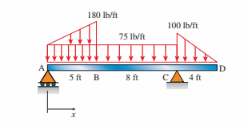In a mass spectrometer a particle of mass m and charge q is accelerated through a potential difference V and allowed to enter a magnetic field B, where it is deflected in a semi-circular path of radius R
The magnetic field is uniform and oriented perpendicular to the velocity of the particle. Derive an expression for the mass of the particle in terms of B, q, V, and R. A)
qB2R2/V
B)
qB2R2/(2V)
C)
q2B2R2/V
D)
q2B2R2/(2V)
E)
qB2R2/(V2)
B
You might also like to view...
A 12.0-kg mass is placed on a 25.0° incline and friction keeps it from sliding. The coefficient of static friction in this case is 0.580 and the coefficient of sliding friction is 0.520 . The mass is given a shove causing it to slide down the incline. Taking down the incline as positive, what is the acceleration of the mass while it is sliding?
a. -1.99 m/s2 c. -0.477 m/s2 b. 1.99 m/s2 d. 0.477 m/s2
The reaction force at C (lb) for the beam below is:
(A) 675 lb
(B) 985 lb
(C) 775 lb
(D) 525 lb

The tail of a comet ________.
A. always points away from the Sun B. always points toward the Sun C. trails behind the comet, pointing away from the Sun as the comet approaches it, and toward the Sun as the comet moves out of the inner Solar System D. points toward the Sun on its way into the Solar System, and away from the Sun on its way out
The density of the Sun is most similar to which object?
A) Halley's Comet's nucleus B) the Earth C) Mercury D) the Moon E) Jupiter